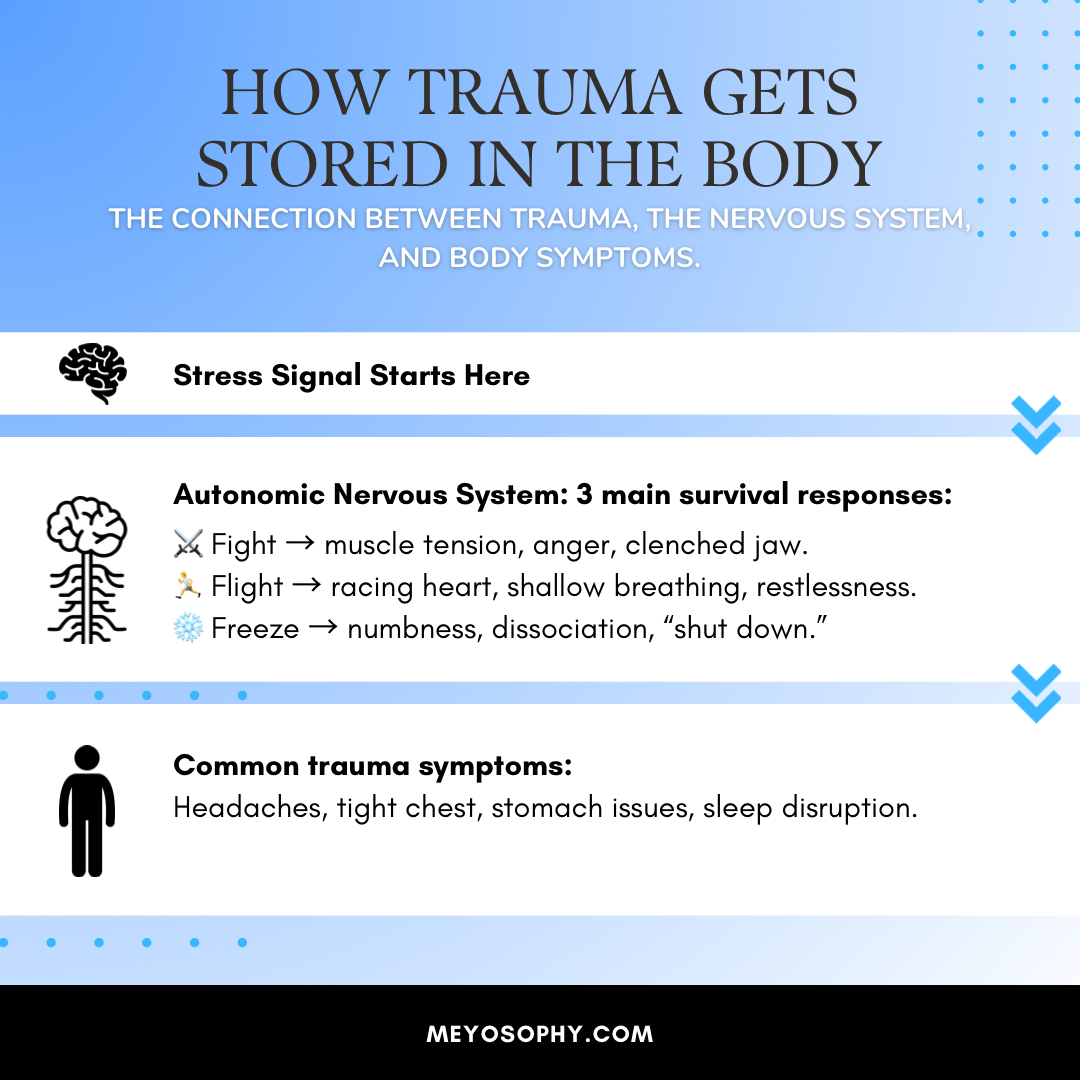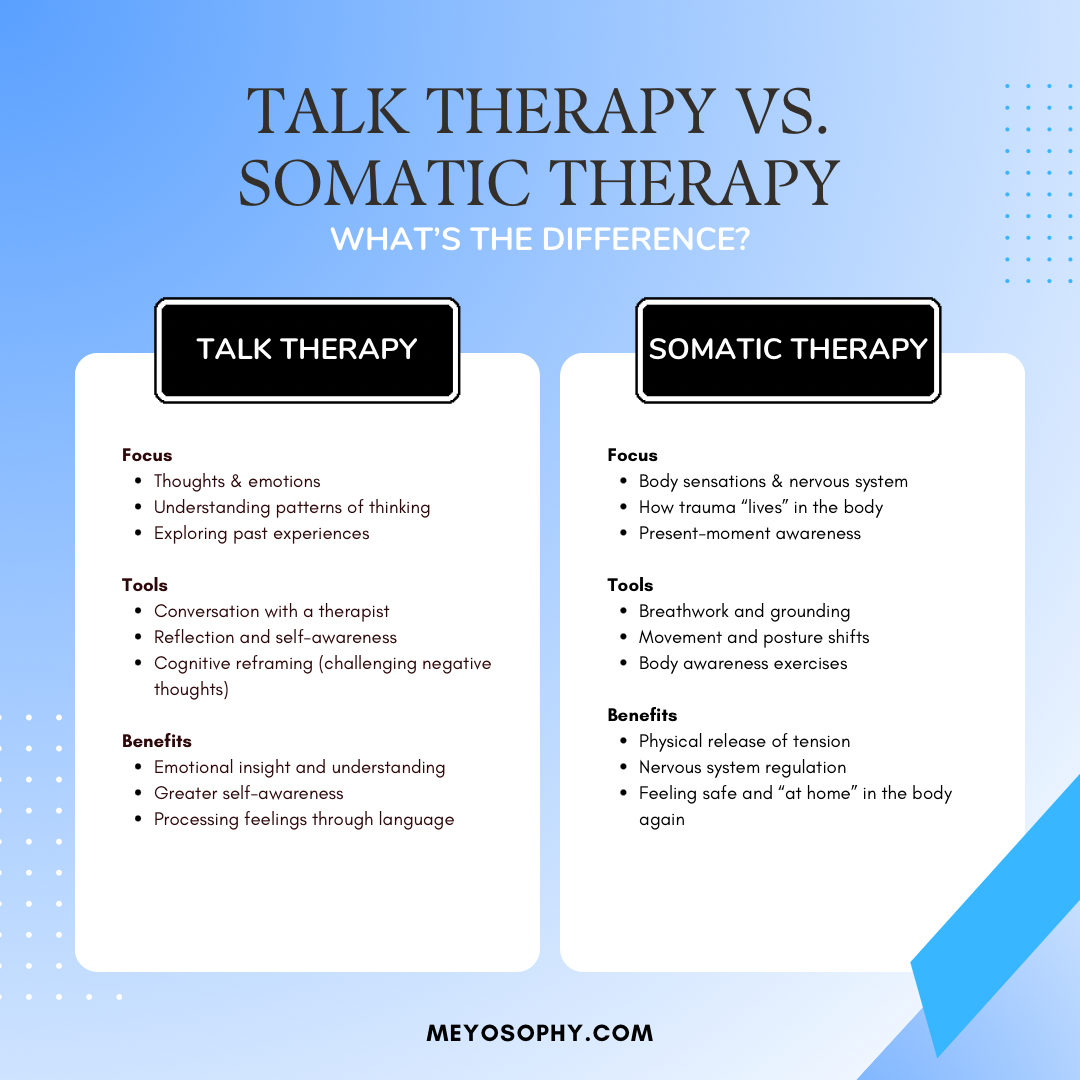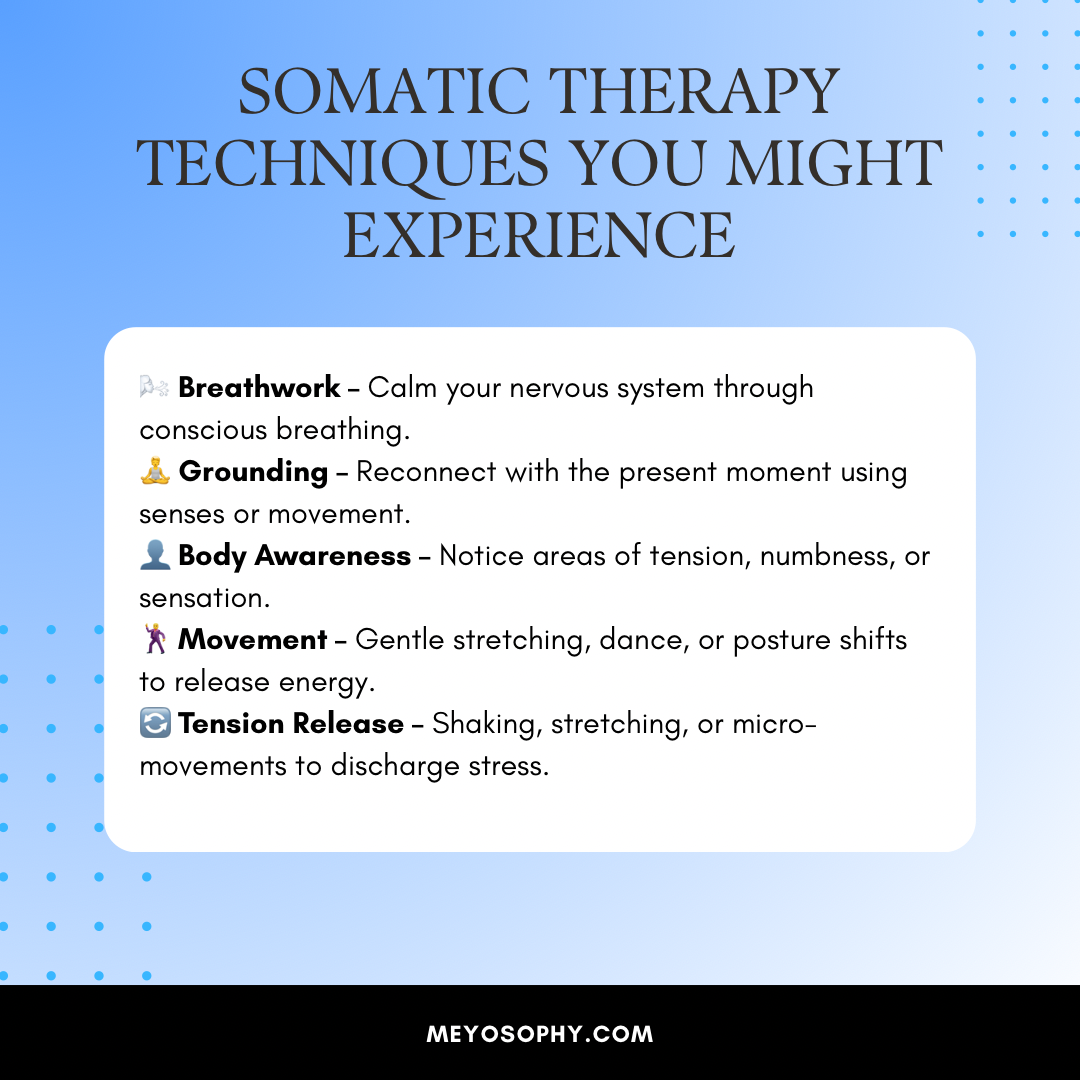When most of us think about therapy, we picture talking to someone about our thoughts and feelings. But what if healing trauma isn’t just about the mind, what if it’s also about the body?
That’s exactly where somatic therapy comes in. This body-based approach to healing is gaining attention for the way it helps people release trauma, stress and emotional pain that can get “stuck” in the nervous system. Harvard Health: “trauma isn’t only a memory in the brain, it can live in the body on a cellular level, shaping how we react to the world around us” [1].
In this blog, we’ll explore what somatic therapy is, how it works and why more people are turning to it as an alternative to traditional talk therapy.
Disclaimer: I’m not a mental health professional, everything here is shared from research and personal experience. If you’re feeling overwhelmed or need support, please consider talking to a qualified professional. You’re not alone. If you’re in the U.S., you can call or text 988 anytime. For help in other countries, visit https://findahelpline.com.
What Is Somatic Therapy?
Somatic therapy is a type of body-centered psychotherapy that combines traditional talk therapy with physical techniques. Instead of focusing only on thoughts and emotions, it helps you reconnect with your body’s sensations: tension, movement, breath, or even stillness.
The word somatic comes from the Greek word soma, meaning “body.” This type of therapy is built on the idea that trauma and stress aren’t just psychological, they are also physiological experiences stored in the body.
How Trauma Gets Stored in the Body
To understand somatic therapy, it helps to know how trauma affects the nervous system. When something overwhelming happens, the body goes into fight, flight, or freeze mode. Ideally, once the danger passes, the nervous system resets.
But sometimes, it doesn’t. Instead, the body stays on high alert. Muscles stay tense, breathing remains shallow and the mind gets stuck replaying the danger. This is why trauma survivors may feel on edge, numb, or disconnected long after the event [2].
The autonomic nervous system (which controls heart rate, digestion, and stress responses) plays a key role here. The vagus nerve, for example, is central to calming the body after stress. Somatic therapy helps re-regulate this system by gently guiding the body back into balance [3].

A Brief History of Somatic Therapy
Somatic therapy isn’t brand new, but it’s becoming more mainstream. Two pioneers are often credited with shaping the field:
- Dr. Peter Levine, who developed Somatic Experiencing in the 1970s, based on studying how animals naturally shake off trauma after life-threatening experiences.
- Dr. Pat Ogden, founder of Sensorimotor Psychotherapy, who integrated body awareness into traditional psychotherapy to help trauma survivors reconnect with their bodies.
Their work has influenced many modern practices that emphasize healing through movement, awareness and sensation.
Different Types of Somatic Therapy
Somatic therapy includes a range of approaches that use the body as a pathway to healing. Here are some of the most well-known approaches:
- Somatic Experiencing (SE) – Developed by Dr. Peter Levine, SE focuses on resolving trauma by working with body sensations instead of re-living painful memories. It helps release trapped survival energy and restore balance in the nervous system.
- Sensorimotor Psychotherapy (SP) – Created by Dr. Pat Ogden, this approach integrates body awareness into traditional talk therapy. Clients learn to notice how their body responds to emotions and practice new movements that build safety and empowerment.
- Hakomi Therapy – A mindfulness-centered method that helps uncover unconscious patterns through gentle attention to body sensations. It encourages self-discovery and healing from within.
- Bioenergetic Analysis – Combines psychotherapy with physical exercises, posture work, and breathing techniques to release long-held muscular tension and emotional blocks.
- Dance/Movement Therapy – Uses expressive movement to improve emotional well-being and create a deeper connection between mind and body. Especially effective for people who process emotions through physical expression.
- Trauma-Sensitive Yoga – A gentle, adapted form of yoga that helps trauma survivors feel safe in their bodies, build resilience and regulate their nervous system through mindful movement and breath.

Common Techniques in Somatic Therapy
Somatic therapy can look different depending on the practitioner, but most sessions combine talk therapy with body-based exercises. Some common techniques include:
- Breathwork – slowing down or deepening the breath to calm the nervous system.
- Movement or dance – using physical expression to release trapped energy.
- Body awareness – noticing areas of tension, numbness, or sensation.
- Grounding techniques – reconnecting with the present moment through touch, sound, or movement.
- Tension release exercises – such as shaking, stretching, or gentle movements to release stress.
These practices encourage the body to process experiences that the mind alone may struggle to resolve.
Talk Therapy vs. Somatic Therapy
Traditional talk therapy focuses on exploring thoughts and emotions. While powerful, it may not always address the physical side of trauma. Somatic therapy adds the missing piece: the body.
Where talk therapy might help you understand why you feel anxious, somatic therapy helps you release the tension sitting in your chest. Many people find that combining both approaches gives them the most complete healing journey.

What Can Somatic Therapy Help With?
Somatic therapy has been used to support people dealing with:
- Post-traumatic stress disorder (PTSD)
- Anxiety and panic attacks
- Chronic stress and burnout
- Depression
- Emotional numbness or dissociation
- Physical symptoms linked to stress, like headaches or muscle pain
It’s especially valuable for those who feel “stuck” in traditional therapy or who notice their trauma shows up in their body as much as in their mind.
Why Somatic Therapies Especially Help With Dissociation and Panic Attacks
One of the reasons somatic therapies are so effective for conditions like dissociation and panic attacks is that they address the root problem in the body, not just the mind. Dissociation often happens when the nervous system becomes overwhelmed and “disconnects” as a survival strategy. Somatic therapy helps by slowly re-establishing a safe connection with physical sensations, grounding the person in the present moment.
Similarly, panic attacks often come with overwhelming body signals (racing heart, shortness of breath, trembling) that can feel uncontrollable. By teaching techniques like breathwork, grounding, and tension release, somatic therapies give people tools to regulate their nervous system in real time. This creates a sense of safety and control, helping the body learn that it no longer needs to stay in crisis mode.
What to Expect in a Session
A somatic therapy session usually begins much like talk therapy: a conversation about what you’re experiencing. From there, the therapist may invite you to notice your breath, track sensations in your body, or try a grounding exercise.
It’s a gentle, collaborative process, you won’t be pushed into reliving trauma. Instead, the therapist helps you move slowly, in a way that feels safe.
Sessions might include:
- Guided breathwork
- Noticing how your body responds when you talk about stress
- Gentle movement or stretching
- Pausing to feel what happens in your body in the present moment
The goal is not to “fix” trauma all at once, but to slowly build safety, resilience and connection with your body (so it can release stored stress).

Is Somatic Therapy Right for You?
Somatic therapy may be especially helpful if you:
- Struggle with anxiety or panic that feels physical (racing heart, tight chest)
- Feel numb or disconnected from your body
- Notice you stay “stuck” in high-stress mode
- Have tried talk therapy but feel like something is missing
If you’re interested, look for a licensed therapist trained in somatic modalities such as Somatic Experiencing or Sensorimotor Psychotherapy. You can often find directories through professional organizations, or ask a trusted therapist for a referral.
Final Thoughts
Somatic therapy offers a powerful reminder: healing isn’t just about the mind, it’s about the whole self. By working with the body, somatic therapy helps release trauma where it often hides, creating space for calm, safety, and connection again.
If you’ve been carrying stress or trauma in your body, this approach may be the missing piece in your healing journey.
Sources
- Harvard Health Publishing. How trauma affects the body. https://www.health.harvard.edu/mind-and-mood/how-trauma-affects-the-body
- American Psychological Association. Trauma and the brain. https://www.apa.org/topics/trauma/brain
- Porges, S. W. (2011). The Polyvagal Theory: Neurophysiological Foundations of Emotions, Attachment, Communication, and Self-regulation. Norton & Company.

